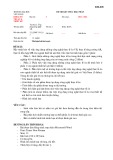
Linear regression (review)

Overview
1. Introduction
2. Application
3. EDA
4. Learning Process
5. Bias-Variance Tradeoff
6. Regression (review)
7. Classification
8. Validation
9. Regularisation
10. Clustering
11. Evaluation
12. Deployment
13. Ethics

Lecture outline
- The regression model formulation
- Understanding the regression results
- Potential problems in regression model (and its training data)

The linear regression formulation
Approximated by
By minimising

An example…
The ‘Advertising’ dataset
- Sales in 200 different markets together with
budget spent on marketing on 3 media types,
TV, Radio and Newspaper.
-Unit of Sales is in ‘thousand units’
-Unit of market budget is in ‘thousand dollars’
We have been given a regression model of Sales
on TV, Radio and Newspaper…


























